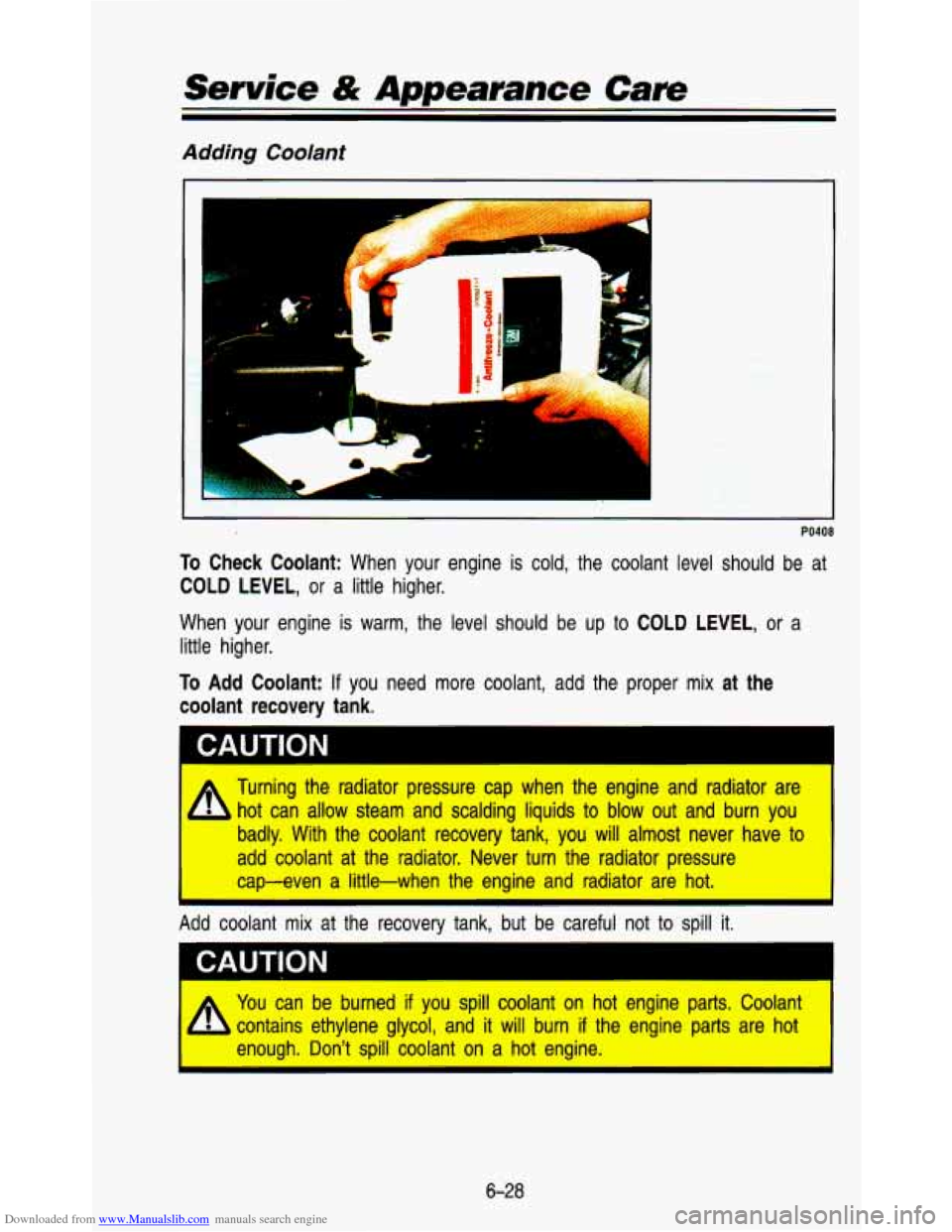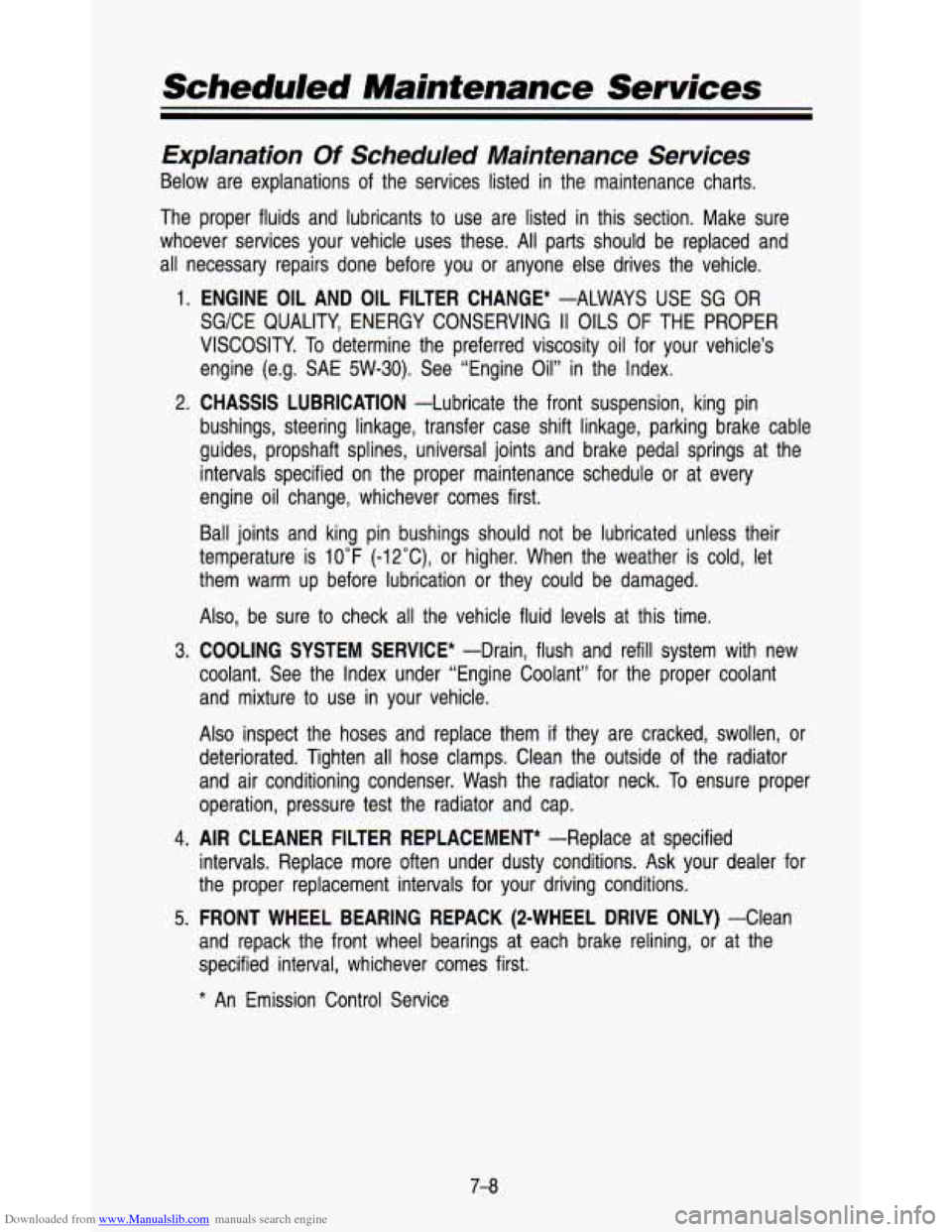Page 214 of 345
Downloaded from www.Manualslib.com manuals search engine If there’s still no sign of steam, push the accelerator until the engine speed is
about twice
as fast as normal idle speed. Bring the engine speed back to
normal idle speed after two
or three minutes. Now see if the warning stops.
But then,
if you still have the warning, TURN OFF THE ENGINE AND GET
EVERYONE OUT OF THE VEHICLE until it cools down.
You may decide not to
lift the hood but to get service help right away.
PO424
When you decide it’s safe to lift the hood, here’s what \
you’ll see:
A. Coolant recovery tank
B. Radiator pressure cap
C. Engine fan
If the coolant inside the coolant recovery tank is boiling, don’t do anything
else until
it cools down.
5-1 0
Page 217 of 345
Downloaded from www.Manualslib.com manuals search engine If the overheat warning continues, there's one more thing you can try. You
can add the proper coolant mix directly to the radiator, but be sure the
cooling
system is cool before you do it.
I CAUTION
II
A
Steam and scalding liquids from a hot cooling system can blow out
and burn you badly. They are under pressure, and
if you turn the
radiator pressure cap-even a little-they can come out at high
speed. Never
turn the pressure cap when the cooling system,
including the radiator pressure cap, is hot. Wait
for the cooling
system and radiator pressure cap
to cool if you ever have to turn
the pressure cap.
I A
PO425
5-1 3
Page 218 of 345
Downloaded from www.Manualslib.com manuals search engine Problems on #he Road
How to Add Coolant to the Radiator
PO422
1. You can remove the radiator pressure cap when the cooling system,
including the radiator pressure cap
and upper radiator hose, is no longer
hot. Turn the pressure cap slowly to the left until it
first stops. (Don't
press down while turning the pressure cap.)
If YOU hear a hiss, wait for that to stop. A hiss means there is Still SOt-t~e
pressure left.
2. Then keep turning the pressure cap, but now push down as you turn it.
Remc- the pressure cap.
PO423
3. Fill the radiator with the proper mix, up to the base of the filler neck,
5-1 4
Page 219 of 345
Downloaded from www.Manualslib.com manuals search engine 4. Then fill the coolant recovery tank to FULL.
t
PO658
5. Put the cap back on the coolant recovery tank, but leave the \
radiator
6. Start the engine and let it run until you can feel the upper radiator hose
7. By this time, the coolant level inside the radiator filler neck may be
pressure cap
off.
getting hot.
Watch out for the engine fan.
lower. If the level
is lower, add more of the proper mix through the filler
neck until the level reaches the base of the filler neck.
I PO407
8. Then replace the pressure cap. Be sure the arrows on the pres\
sure cap
line up like this.
5-1 5
Page 264 of 345

Downloaded from www.Manualslib.com manuals search engine Service & Appearance Care
Adding Coolant
PO408
TO Check Coolant: When your engine is cold, the coolant level should be at
COLD LEVEL, or a little higher.
When your engine is warm, the level should be up
to COLD LEVEL, or a
little higher.
CAUTION
To Add Coolant: If you need more coolant, add the proper mix at the
coolant recovery tank.
Turning the radiator pressure cap when the engine and radiator \
are
hot can allow steam and scalding liquids to blow out and burn you
badly. With the coolant recovery tank, you will almost never h\
ave
to
add coolant at the radiator. Never turn the radiator pressure
cap-even a little-when the engine and radiator are hot.
I
Add coolant mix at the recovery tank, but be careful not to spill it.
CAUTION
i You can be burned if you spill coolant on hot engine parts. Coolant
- contains ethylene glycol, and it will burn if the engine parts are hot
enough. Don't spill coolant on a hot engine.
6-28
Page 265 of 345
Downloaded from www.Manualslib.com manuals search engine Radiator Pressure Cap
PO407
"wr radiator pressure cap is a 15 psi (1 05 kPa) pressure-type cap and
wst be tightly installed to prevent coolant
loss and possible engine
damage from overheating. Be sure the arrows on the pressure cap
lir
with overflow tube on the radiator filler neck.
I
I
When you replace your radiator pressure cap, ul~ AC@ cap is IGdommendGu.
Thermostat
Engine coolant temperature is controlled by a thermostat in the\
engine coolant
system. The thermostat stops the flow
of coolant through the radiator until the
coolant reaches a preset temperature.
When you replace your thermostat, an AC@ thermostat is recommended.
6-29
Page 306 of 345
Downloaded from www.Manualslib.com manuals search engine Service & Appearance Care
Service Replacement Parf and Filter
Recommendations Table
Engine cap
Filter
Plugs Valve
Cleaner
Filter
(VIN) Radiator
Fuel
Spark"
PCV Air Oil
4.3L (Z) PF51 A773C
*Use copper-cored resistor type spark plugs. RC36 GF481
.CR43TS CV892C
A1163C PF51
4.3L (W)
RC36 GF481
CR43TS
CV789C
Filter
TO005
6-70
Page 314 of 345

Downloaded from www.Manualslib.com manuals search engine Scheduled Maintenance Services
Explanation Of Scheduled Maintenance Services
Below are explanations of the services listed in the maintenance charts.
The proper fluids and lubricants to use are listed in this section. Make sure
whoever services your vehicle uses these. All parts should be \
replaced and
all necessary repairs done before you or anyone else drives th\
e vehicle.
1. ENGINE OIL AND OIL FILTER CHANGE* -ALWAYS USE SG OR
SG/CE QUALITY, ENERGY CONSERVING II OILS OF THE PROPER
VISCOSITY.
To determine the preferred viscosity oil for your vehicle’s
engine (e.g. SAE 5W-30). See “Engine Oil” in the Index.
bushings, steering linkage, transfer case shift linkage, parking \
brake cable
guides, propshaft splines, universal joints and brake pedal spri\
ngs at the
intervals specified on the proper maintenance schedule or at ev\
ery
engine oil change, whichever comes first.
2.
CHASSIS LUBRICATION -Lubricate the front suspension, king pin
Ball joints and king pin bushings should not be lubricated unl\
ess their
temperature is
10°F (-12”C), or higher. When the weather is cold, let
them warm up before lubrication or they could be damaged.
Also, be sure to check all the vehicle fluid levels at this time.
3.
COOLING SYSTEM SERVICE* -Drain, flush and refill system with new
coolant. See the Index under “Engine Coolant” for the pro\
per coolant and mixture to use in your vehicle.
Also inspect the hoses and replace them
if they are cracked, swollen, or
deteriorated. Tighten all hose clamps. Clean the outside of the radiator
and air conditioning condenser. Wash the radiator neck.
To ensure proper
operation, pressure test the radiator and cap.
4. AIR CLEANER FILTER REPLACEMENT* -Replace at specified
intervals. Replace more often under dusty conditions. Ask your \
dealer for
the proper replacement intervals for your driving conditions.
5. FRONT WHEEL BEARING REPACK (2-WHEEL DRIVE ONLY) -Clean
and repack the front wheel bearings at each brake relining, or at the
specified interval, whichever comes first.
* An Emission Control Service